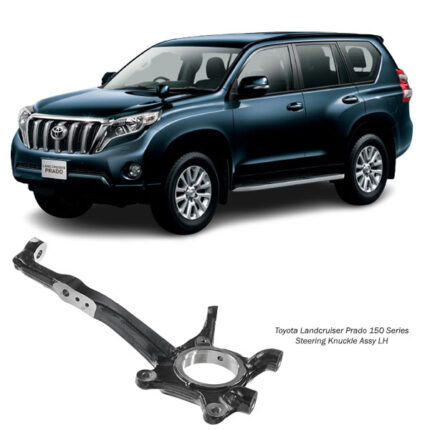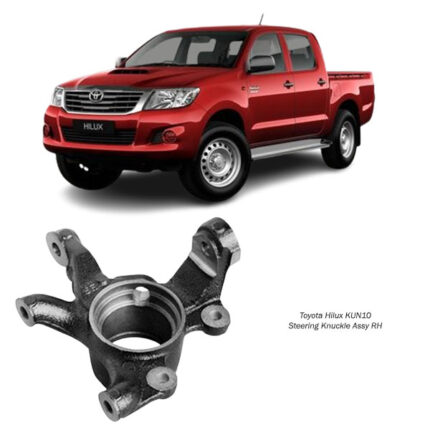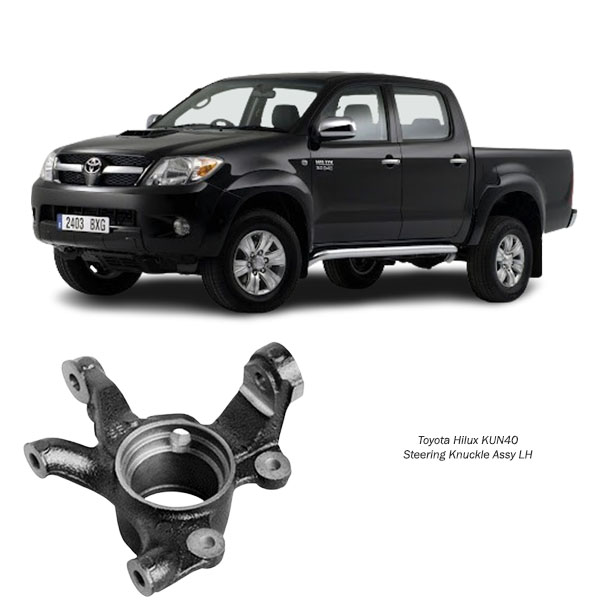-9%
Get Toyota Hilux KUN40 2WD Steering Knuckle Assy LH 43212-0K070 in Kenya
Every time you turn your steering wheel, glide through a corner, or stop at a red light, there’s a silent worker at play — the Steering Knuckle Assembly LH (Left Hand). Though it doesn’t get much attention, this component plays a critical role in the smooth operation of your vehicle. Let’s unravel the mystery behind this tough, load-bearing, direction-controlling part of your suspension system. 💪🚘
What is the Steering Knuckle Assembly LH? 🤔
The steering knuckle is a strong metal component located at the wheel hub, acting as a bridge between the suspension system, the wheel, the brake assembly, and the steering components. The “LH” stands for Left Hand, indicating it is installed on the left side of the vehicle — whether that’s the driver’s or passenger’s side depends on your steering orientation.
While small in size, this part serves as the pivot point that allows your wheels to turn, your suspension to absorb bumps, and your brakes to bring the vehicle to a stop — all while bearing the load of the car. 😮💨🛞
Key Functions of the Steering Knuckle 🧠⚙️
Let’s explore the main jobs this underrated assembly performs:
🔄 1. Wheel Rotation Support
At the heart of every turn and straightaway, the steering knuckle supports the wheel hub and bearing, allowing your wheel to rotate freely while staying securely in place.
🧭 2. Steering Link Connection
The knuckle connects to the tie rod, which is part of your steering linkage. When you turn the steering wheel, the motion is transmitted through the tie rod to the knuckle, allowing the wheel to pivot left or right.
🛑 3. Brake Component Mounting
Calipers and brake rotors are typically mounted to the knuckle. When you apply the brakes, the calipers clamp onto the rotor, which is attached to the wheel via the knuckle — creating the stopping force you rely on every day.
🧱 4. Suspension Integration
It connects to upper and lower control arms or a strut and lower arm, depending on the suspension design. This allows the wheel to move up and down independently of the car’s body — improving ride comfort and control.
⚖️ 5. Load Distribution
The knuckle helps distribute vehicle weight through the suspension system and into the wheels, helping keep the car stable under acceleration, braking, and cornering.
What’s Included in a Steering Knuckle Assembly? 🧩
When we talk about a knuckle assembly, we often refer to a more complete package — not just the bare casting. It may include:
-
Wheel hub: A mounting point for the wheel and connection to the axle.
-
Wheel bearing: Allows smooth wheel rotation with minimal friction.
-
ABS sensor mounts: Housing or location for the wheel speed sensor 🧲.
-
Brake backing plate or dust shield: Helps keep debris off the rotor 🛡️.
-
Ball joint connection points: For linking to control arms or struts.
-
Caliper bracket mounts: To attach the braking system firmly.
Each of these pieces plays its part in a well-functioning front end. By being bundled together, an assembly ensures precise alignment, proper geometry, and easier installation during repairs or replacements. 🔧✨
Construction and Materials 🔨
The steering knuckle is typically made of forged steel, cast iron, or aluminum alloys depending on the design and vehicle weight requirements. It must be both incredibly strong and precisely machined, as it endures enormous forces during driving — including:
-
Impacts from potholes and bumps 🕳️
-
Weight transfer while cornering or braking 🌀
-
Rotational forces from the wheels 🔁
-
Vibrations from uneven roads 🌍
The design has to maintain exact angles to keep steering alignment, brake efficiency, and wheel tracking perfectly balanced. A small deformation in the knuckle can lead to serious drivability problems.
Why It’s So Important 🚨
Although hidden behind wheels and fenders, the steering knuckle has a foundational role in your vehicle’s dynamics. Here’s why it’s so crucial:
-
🛞 It secures your wheel to the suspension
-
🛠️ It ensures proper steering response
-
🔧 It maintains correct suspension geometry
-
🧷 It houses essential components like bearings and sensors
-
🚦 It supports brake calipers for safe braking
Without a properly functioning knuckle, your steering and suspension could become unstable — affecting safety, handling, and tire wear.
Common Issues and Symptoms ⚠️
Though it’s built for durability, the steering knuckle can become damaged or worn due to:
-
Accidents or curb impacts 💥
-
Severe potholes or off-road abuse 🌄
-
Corrosion over time 🌧️
-
Improper installation of components 🧷
Here are some warning signs to look out for:
🌀 Steering feels loose or wobbly
This may be caused by a worn knuckle or loose connection points.
↪️ Vehicle pulling to one side
Could indicate misalignment due to a bent knuckle or mounting issue.
👟 Uneven or rapid tire wear
If the knuckle is misaligned, it affects suspension angles and causes abnormal tire wear.
🔊 Clunking or knocking sounds
Especially when turning or going over bumps, which can suggest wear in the ball joint connection or hub.
🚨 Vibration during braking or turning
This could be caused by damage in the wheel bearing or brake mounting area within the knuckle.
If any of these signs appear, it’s best to have the suspension and steering inspected — ignoring it could lead to bigger problems down the road. 🚧
Final Thoughts 🧠💡
The Steering Knuckle Assembly LH is one of those parts that quietly keeps everything working like clockwork. From holding the wheel in place to helping your car steer, stop, and absorb bumps — it does all this without ever seeking attention. 🏁
Though it may not be the flashiest part of your ride, its importance can’t be overstated. Whether you’re cruising on the highway, navigating city traffic, or taking a sharp turn — the knuckle is at the center of it all, keeping you stable, safe, and in control. 🛞🛡️
Next time you admire your car’s performance or feel that smooth turn through a corner, just remember: your Steering Knuckle Assembly LH deserves some silent appreciation.
Follow us on Facebook for more parts.




Reviews
Clear filtersThere are no reviews yet.